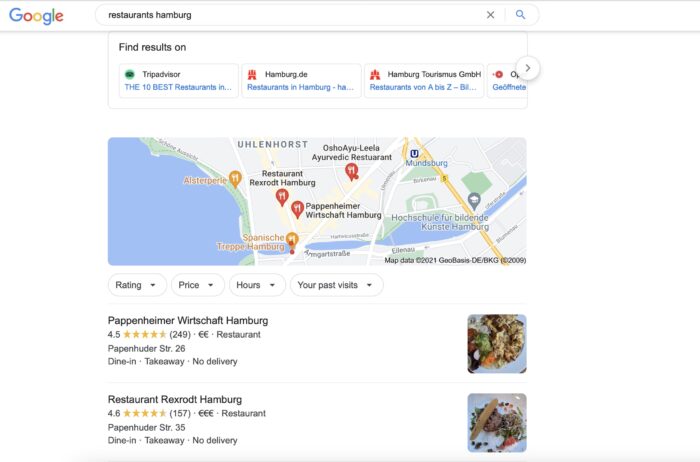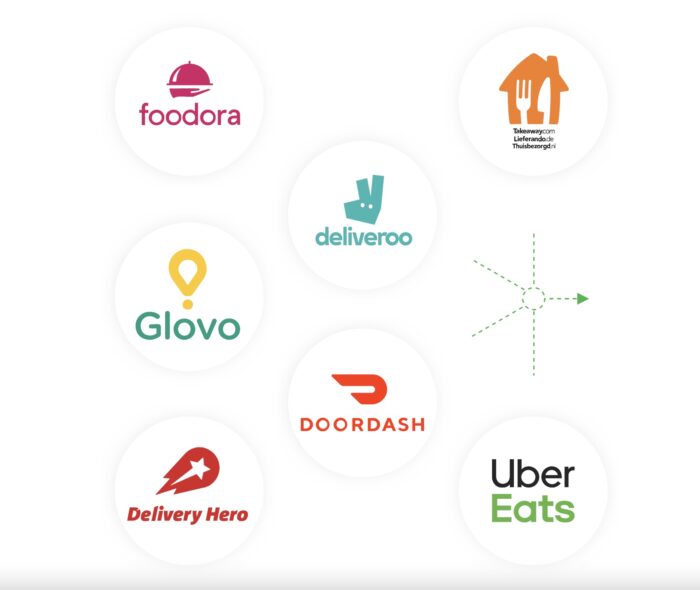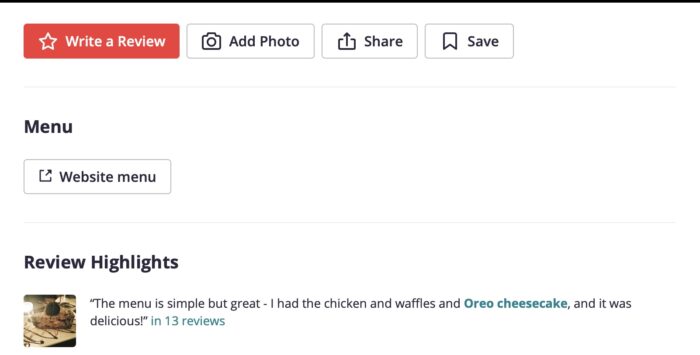As people are returning to dining and catering venues after the pandemic, attracting customers in your direction is more important than ever. Restaurant SEO, social media, and digital marketing techniques can make sure your company’s events and venues are getting the first seat at the table.
Online marketing strategies can be very important in producing an optimal mix of online food orders and in-person visits. Online promotions can also easily attract customers with below-the-line promotions, discounts, and special offers. Implementing such promotions and keeping track of their success is also much easier.
Building Better Restaurant SEO
Search engine optimisation for restaurants can be key as most interested parties only look at the first page of Google. Getting better positioning here can be challenging since the food sector is highly competitive. While it’s easier to achieve this with PPC and paid results, getting your rankings higher using organic means has its own specific benefits.
Optimising Restaurant SEO for Events vs. Venues
Getting your restaurant to show up on the first page of Google can be complex without a coherent plan. It also requires knowing in what ways you want to show up because Google searches can vary wildly. For example, would you want to show up in the Maps 3 pack as a restaurant or is your plan to attract people to an event? The former is great for establishments but the latter is more appropriate for one-off events.
It’s important to note that it shouldn’t be one or the other. One-off events that link to your website will help with better website SEO in the long run and better website performance will naturally make your events more visible. You need both approaches to work in tandem as they help each other but also could attract different target groups.
For events, more extensive reading in a similar vein is available in our previous article on event SEO. However, here are a few short tips on boosting events:
- Post events on social media and pre-plan around holidays. These can be busy periods, so getting your name out first is crucial.
- Start up a birthday club or special offers for such occasions.
- Advertise promotions geared towards your target group (e.g. student discounts).
- Implement discounts for large groups like office parties or external event catering.
Local Restaurant SEO is key

When it comes to attracting in-person visitors, most people will discover your establishment through what is around them. This means that you need to reference your location on your website, optimise your Google My Business profile, and make use of a number of sites, online maps, and location-based apps.
One often-neglected tool for local rankings is Google My Business posts. Posts increase visibility on Google, provide new information that can make you stand out in the eyes of the customer, and allow for a free and accessible form of online marketing communication. You can post pictures, CTAs, and updates that generate buzz. The recommended amount is once per week.
In terms of making the most of your location on Google maps, restaurant business’ online marketing can benefit immensely in multiple ways. For one, it’s an easy link to your website and conveys basic information like opening hours. Secondly, ending up in the 3-pack or carousel on Google Maps gives you an unprecedented level of visibility.
There are key bits of information you need to provide in your Maps post. The local restaurant attendees will want to know price levels, opening and closing times, whether a place provides takeaway or dine-in options, and what types of food they provide.
Pictures and videos can go a long way in drawing people in. Remember to link to your website within the Maps page. A small introduction is also useful in giving basic information about your services..
Keyword Planning
Check out what services or foods are most popular among customers. You don’t have to change your restaurant’s entire theme to cater to these, but rather notice what you already provide and whether you’re optimising towards the people searching for it. Maybe you provide chicken wings and a lot of people are searching for those, but you haven’t listed it as a speciality on delivery sites so people never find your page.
Be specific. Optimising keywords on Google for restaurants and dining places requires listing specific food items. The best restaurant SEO tactics take into account very specific needs. Sometimes people will Google for particular foods but other times it can be as simple as looking for a place to sit down have a coffee and use the free WiFi.
Cover your bases with services as well. Create a separate page for catering and a different one for dining in and ordering. This helps the search engine target different search terms. It also helps target very different customer segments. Catering services (as one example) are more likely to attract venues and businesses with large amounts of people attending. This already expands your online targeting beyond individual attendees.
Delivery Sites Help Restaurant SEO

Aside from your main website, one of the top-ranking links is usually a link to some 3rd party restaurant ordering app. These apps are handy and put you in a place where you can attract general customers and local businesses.
You have little control over these, but you can influence what information your customer sees. It helps to add pictures of food next to the selections. You’d be surprised how few restaurants make use of this and how much this simple step can help the customer out.
With fast food orders, online presence through delivery sites can be key. However, some restaurants don’t have a food format that fits these sorts of platforms. In those cases, restaurants need to emphasise strategies that get people to use their services in person. This is where a more event-oriented approach is useful, as it is more likely to get people to attend.
Targeting Tips
Restaurants can vary heavily in terms of who they target. You probably already know your target group. However, for some restaurants, the customer segmentation might be too general to define with precision. In these instances, we recommend seasonal or circumstantial targeting based on things like events and times of the year.
In terms of getting your target market, most people will be searching for places on their phones. This is especially true for impulse customers, i.e. those who weren’t planning on eating but find themselves looking for a place to eat. For example, 72% of Black Friday shoppers visit a restaurant while shopping. So events like this or Christmas might especially be a time to boost your ad-spend and update your restaurant SEO.
If you serve a lot of desserts, holidays like Christmas or Valentine’s Day might be prime opportunities. Try targeting people who fit the profile (e.g. couples in the correct age bracket, families, office parties etc.) to buy such seasonal delicacies. Similarly, offering catering to Christmas parties or even Friday brunches could be a good means of finding customers. Don’t just target individuals, but also try full companies, events, or food conventions.
Restaurant Content Strategy
Nowadays, well-performing content is must-have for any restaurant’s marketing strategy. But this doesn’t necessarily mean you need to keep making blog posts on a regular basis (although it doesn’t hurt). Visual content is becoming more and more important, so lean into memes, videos, food images etc. All of these can be more attractive to the viewer and perform better than other forms of content (if done correctly).
Customer Reviews

Reviews are a major part of any restaurant’s online marketing strategy. Aside from Google’s review system, sign up to restaurant review sites like Yelp, Foursquare, and TripAdvisor. Encourage your users to post reviews and recommend the site. Places with the best restaurant reviews are known to perform better as customers really value word of mouth.
Google actively favours pages that have 1) more reviews and 2) more engagement overall. This is a neat way to get both of those. It’s also a means of getting crucial feedback. For example, when someone posts on one of these sites or on Google Maps, you sometimes learn how they’re finding your restaurant. Even bad restaurant reviews tell you something about your service.
Apps like Takeaway.com are also great for obtaining reviews and ratings. They often send customers an email asking for reviews. If you have high ratings on Uber Eats or any other such platform, display that in your marketing.
Leverage User-Generated Content
Restaurant content writing efforts don’t have to be all your own. There are other ways to get creative with customer content as well. In the era of crowd-sourcing people are all but eager to do your marketing for you.
Maybe you offer limited-time discounts to people who post your food and tag you on Instagram. Perhaps you can offer a raffle where if someone shares your page to their friends they have a chance of winning a free meal. Market your restaurant by taking a customer-centric approach rather than just internal brand-building efforts. Customers are the cornerstone of the food service industry after all.
Next, build an audience of loyal customers that you can communicate with easily. Social media platforms are there to build communities. Get people to join your restaurant’s Instagram or Facebook page so they can stay updated with future events. Post restaurant videos or share positive feedback from restaurant review websites and blogs.
Influencer Marketing
Sadly, all of this also means that social media content for restaurants works best when others make it. The food service industry is one built on word of mouth and good reviews. That’s why you should encourage food bloggers, Instagram users, YouTubers, etc. to film their own content.
External blogs can be useful in link-building, which instantly improves your visibility on search engines. Aside from food blogs, food reviews from news websites or tabloids work well, but official sources like these can be harder to acquire. Social media marketing is cheaper and reaches a lot more people, so it should be your primary concern.
Restaurant Website Design & Social Media Page Tips
Add a restaurant menu to the Facebook page or other social media. In fact, a Facebook marketing strategy for restaurants can be very versatile. The platform can operate as a marketing tool, it can easily highlight good restaurant reviews, act as an online restaurant reservation system, and operate as a payment platform for tickets and event registration. The best restaurant Facebook pages use all of these features to create a central hub for customer engagement.
Although there is a downside to relying on social media: it distracts from your own website. Use it wisely, because it is a double-edged sword. It would be best if you could find a way to guide users from an external page to yours. Some restaurants offer exclusive ticket buying or reservations redirected to their own websites. Others inform users that meals are cheaper if they use the website’s delivery order placement system (it cuts out the fees for the middleman in many delivery apps).
That said, there is a way to use social media and search engines to attract people to your restaurant…
PPC Strategy
PPC ads must operate in confluence with your restaurant SEO strategy. SEO will help you procure organic results, while PPC will net you customers more directly. PPC often attracts people looking for a specific service rather than those people who are casually searching without strong buyer intent.
PPC content for restaurants comes in many different forms. Post pictures of new mouth-watering dishes to get customers interested in your restaurant. You can try videos, but this works better for established brands (big names like McDonald’s), so the competition will be fierce. You could also provide discounts and giveaways.
Optimise Your Ads, Sites, & Social Media for Mobile
89% of dining research is done by mobile. Need I say more about the importance of optimising for mobile devices?
When it comes to social media and ads, know the medium you’re operating in. For example, match the format on Instagram: portraits do better than landscapes on mobile phones.
Aside from content, the same goes for restaurant advertisements. Check how well your websites and delivery sections on apps perform on mobile as well. This means as little typing as possible. Rely more on easily understandable, clickable options, auto-filling addresses, simple customer account management etc.
Making a reservation at a restaurant should be a few swipes and taps away. If it’s too complicated, people will become discouraged and your competition wins another customer. NOTE: This is why you should monitor your bounce rates, noting where customers are leaving and making adjustments accordingly.
Plan for Remarketing
There are a bunch of ways to remarket and retarget using your website. When someone makes an online order, make sure you have the option to send them updates and deals. This is one of the benefits of having your own delivery and reservation page rather than relying on a 3rd party.
Keep the email lists of people who order frequently and try to give them unique value propositions. Remarketing campaigns can include new dishes, holiday specials, seasonal offers, and discounts. You can also use them to pass on promo codes and giveaways. As mentioned earlier, you can also ask them for reviews (sometimes in exchange for discounts).


